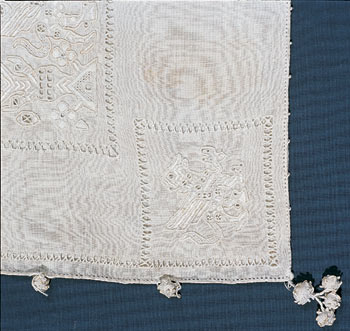The Art of Embroidery in the Town and
Locality of Pistoia
The Museo del Ricamo (Embroidery
Museum) is located on the ground floor of Palazzo Rospigliosi, which also houses
the Rospigliosi and the Diocesan Museums.
For centuries, until recent times,
Pistoia was rightly considered to be a centre of excellence for the production
of embroidered cloth and the Museum has been created to preserve, maintain and
exhibit many of the beautiful items produced. The documents, sources and
numerous exhibits (17th- and 18th-century) are evidence of
the widespread and deeply rooted activity of embroidery in the city, where the
convents and enclosed orders, and later female educational institutes, ensured
the survival of the practice, tradition, style, characteristics and methods of
needlework used for both secular luxury and ecclesiastical pomp.
|
The success of Pistoia in the art of
“whitework” (in bianco) and “white embroidery” (sul bianco)
began in the 19th century as the result of the growing demand for
lingerie and household linens enhanced with intricate embroidery that were
indicative of the importance and social level of those to whom they belonged. In
Pistoia a lively and positive source of female employment developed within this
specific sector and at the end of the 19th and beginning of the 20th
century both craft and industrial production of an international level and
quality flourished and, despite trends and fashions, still continues today.
In addition to their work with house and
children, the craft of embroidery provided women with a source of income and a
way of improving the family budget.
The craft developed during the 1920s and
1930s in particular, with the appearance of 'school-workshops' created and
financed by ladies of the local aristocracy. In addition to the vast range of
stitches used, the success of embroidery production around Pistoia was
responsible for the creation of some original and specific styles such as sfilati
('ravelled' thread?), the punto antico (antique stitch), also known as
the punto toscano (Tuscan stitch) and the punto di Casalguidi
developed in the town of Casalguidi, near Pistoia.
|
|
To preserve the memory of this ancient
tradition and contribute to the reconstruction of its history, the Museum houses
items and documents of all kinds, provided through donations and loans. Due to
the quantity of materials still available from private individuals and
ecclesiastical bodies, the Museum will be able to change the display in
rotation, and also forsees thematic exhibitions dedicated to particular
techniques or styles of production.
In
addition, the Museum offers a centre
of research, documentation and teaching embroidery skills and history.
